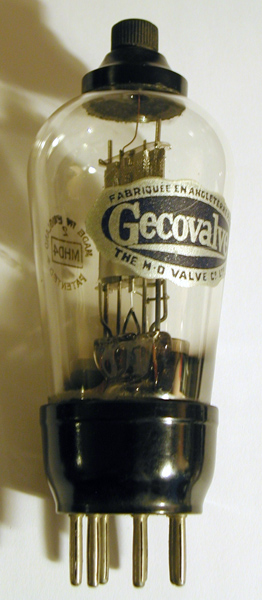|

The Osram MHD4 as featured below.
Some facts about the possibilities of a very interesting innovation in valve design.
One of the most versatile valves ever introduced, from the point of view of the number of circuit variations that can be weaved about it, is the double-diode triode the Osram example of which we have just been putting through its paces in the laboratory.
As you probably remember, the DDT (as it is called for short) consists of two valves in one envelope. There is a common cathode for the two sections, but while at the lower end there are two anodes and no grid (for diode rectification), at the upper end there is another anode and a grid for normal triode amplification. The valve is designed, of course, for use on AC.
Both sections are screened from each other, so that there is no interaction between the two, and we can use the valve in a number of ways. One of the primary reasons for its design is the use of diode rectification, to avoid detector overloading and consequent distortion, while the use of the diode section for AVC as well must not be overlooked.
Several Uses
On test the valve acts excellently in many capacities, though the various modes of applying AVC with it naturally vary considerably in their effectiveness. One of the best methods seems to be to use the two diodes as full-wave rectifier, and then to employ the triode part for ordinary 'signal' detection.
This results in plenty of potential for the automatic volume control with sensitive rectification, and a certain amount of amplification where the detector is concerned. Something has to be sacrificed, of course, and this is the purity of reproduction that could have been obtained if diode 'signal' rectification had been employed. Instead, the results are comparable in purity with those obtained with a normal leaky-grid triode detector.
Those who want AVC and diode 'signal' rectification can use half-wave rectification for AVC using one diode, and the other diode to give half-wave rectification for programme, reproduction purposes. Again, full-wave rectification can be arranged for the 'signal' and AVC tapped off the resultant potentials developed.
The automatic volume control obtainable from the double diode-triode can be either of the, direct or delayed type, the latter being very much more satisfactory from the point of view of sensitivity of distant reception. In this case the AVC diode is biased so that it does not commence to apply any checking voltage to the HF stages until the incoming impulses have been amplified to a certain strength, which is predetermined by a simple resistance adjustment.
There are so many variations that can be made in circuits associated with the DDT valve that it is impossible to give but a brief idea of its possibilities here, though there is one use of the valve which should appeal to home constructors who do not worry about automatic volume control and its intricacies but who are concerned with pure reproduction and economy of set construction.
This is the employment of the double-diode triode as a half- or full-wave rectifier with no automatic volume control, and as the first LF amplifier in the set, In this case the volume control is carried out by hand, by means of multi-mu SG or pentode valves, and the fact that the DDT valve has both diode and triode in one envelope enables a valve to be cut out of the circuit, with obviously increased economy.
Improved Quality
Diode rectification is well worth while from the point of view of purity of reproduction but it is purely rectification, and a valve used thus will not amplify at all. Consequently, with this type of detector we have to have one LF valve extra to that required when we use a triode or tetrode rectifier. The double-diode triode fills both bills at once.
The Osram DDT takes the normal 4 Volts and 1 Amp of heater current, and has excellent triode characteristics. The slope is some 2.2 milliamps per volt, while the impedance is 18,200 Ohms. This gives an amplification factor of 40. The price is 15s. 6d.
The triode section represents an ordinary valve whilst the double-diode section has numerous possibilities for rectification and so forth, as explained above.
|